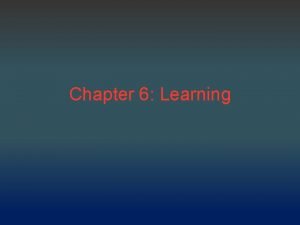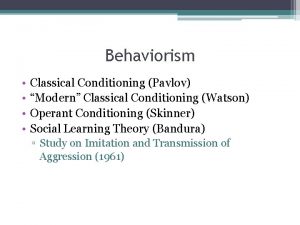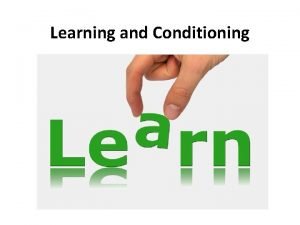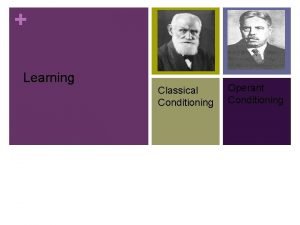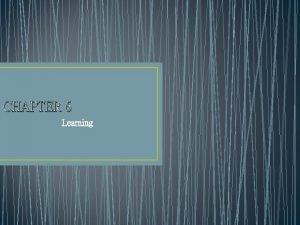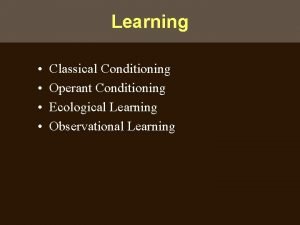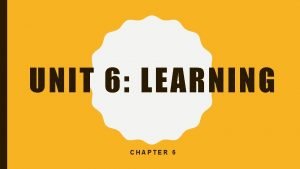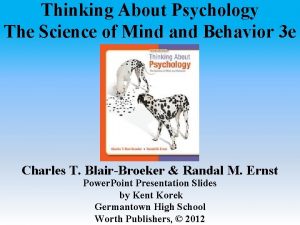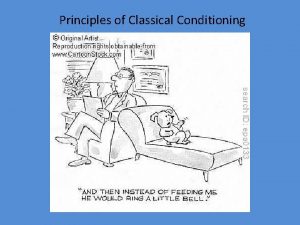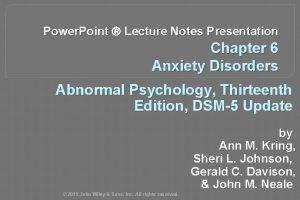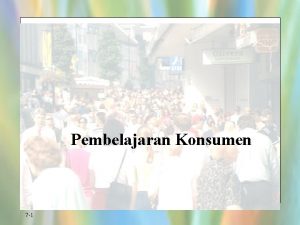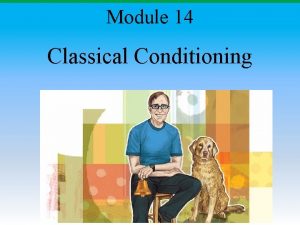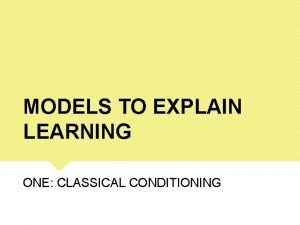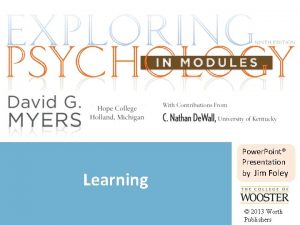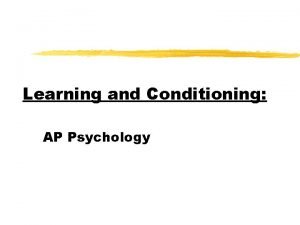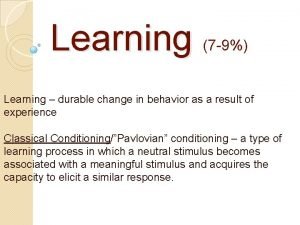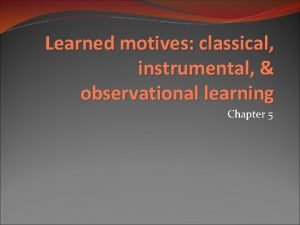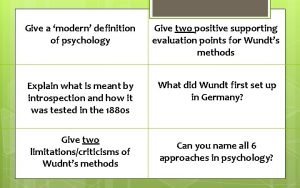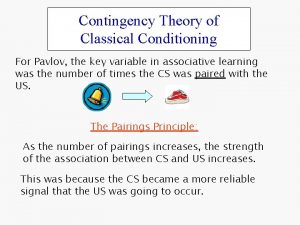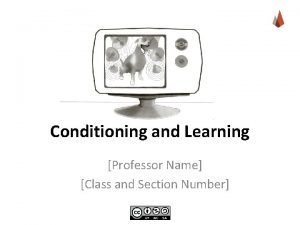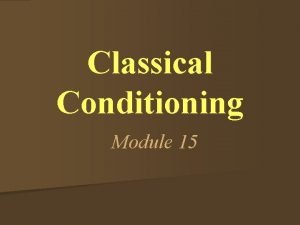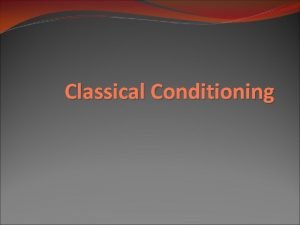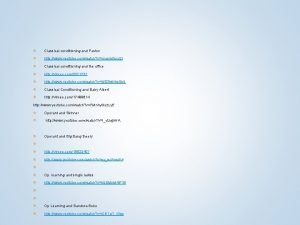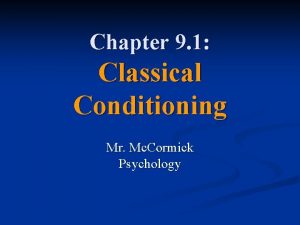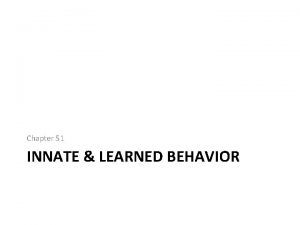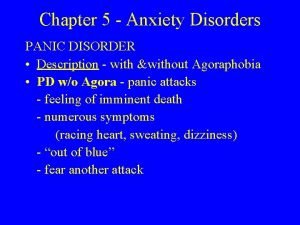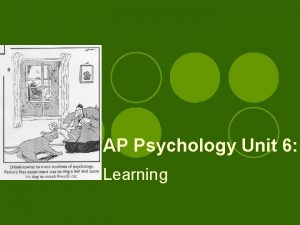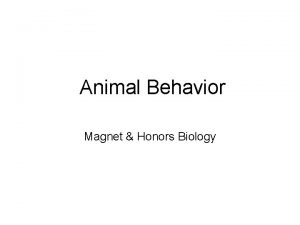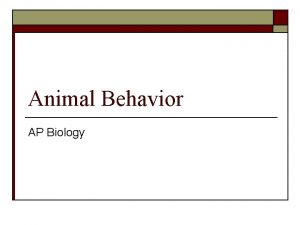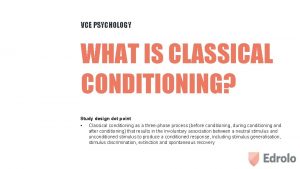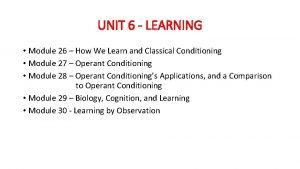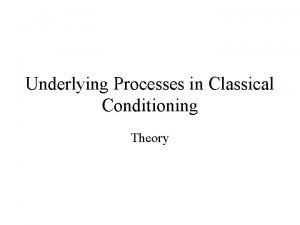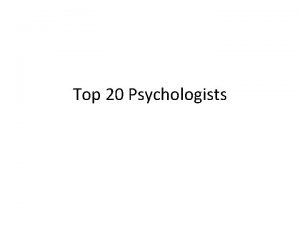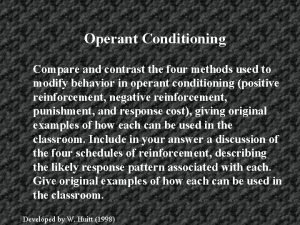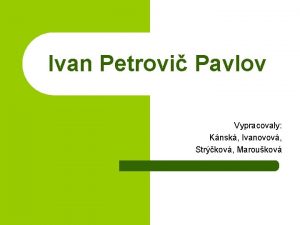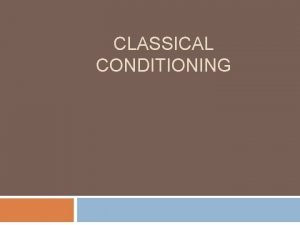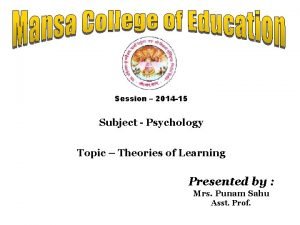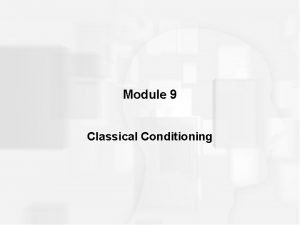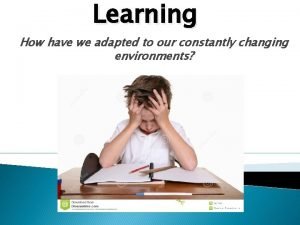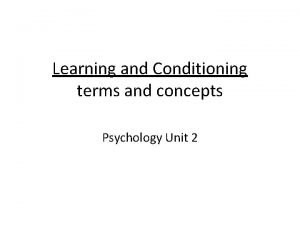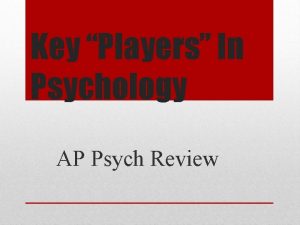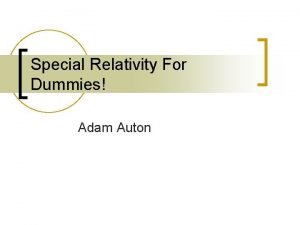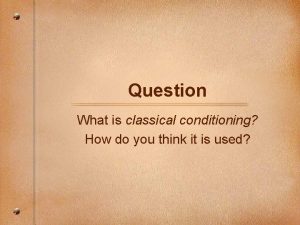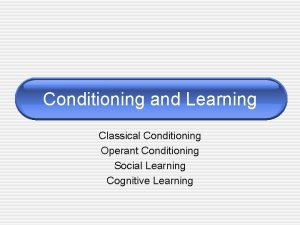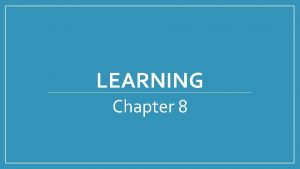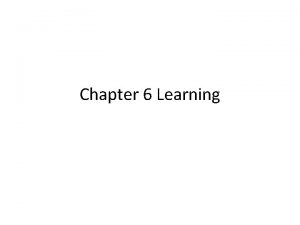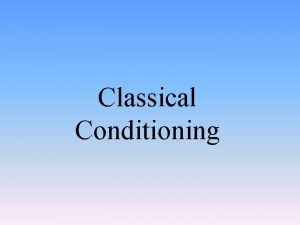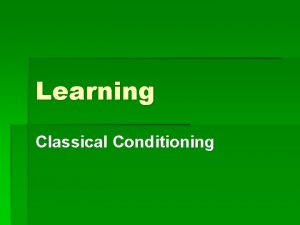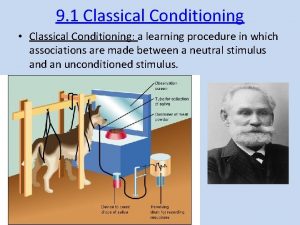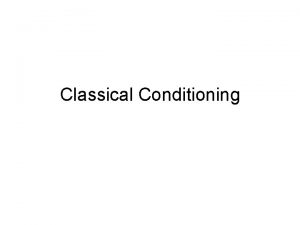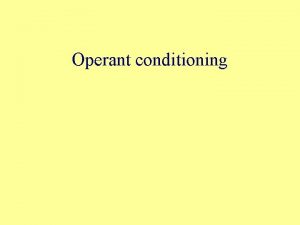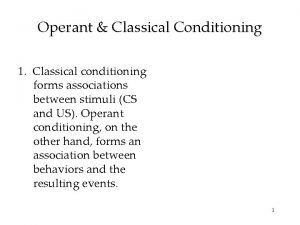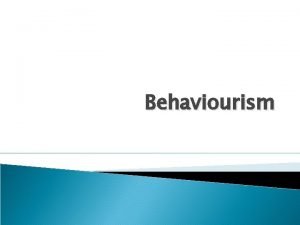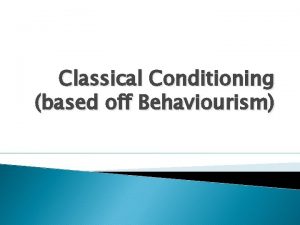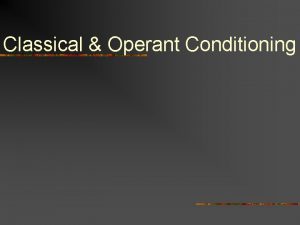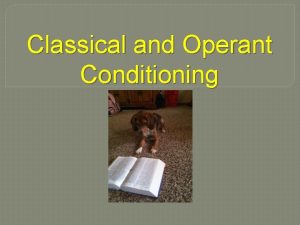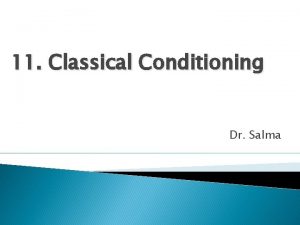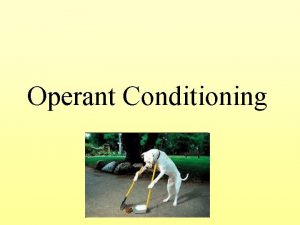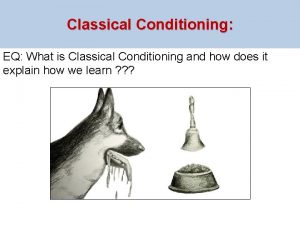UNIT 6 LEARNING CHAPTER 6 CLASSICAL CONDITIONING CHAPTER























































- Slides: 55

UNIT 6: LEARNING CHAPTER 6

CLASSICAL CONDITIONING CHAPTER 6, SECTION 1, PAGES 185 -193 PURPLE BOOK: CHAPTER 6, SECTION 1, PAGES 202 -211

CLASSICA L CONDITIONI N G PART A CHAPTER 6, SECTION 1 A, PAGES 185 -190 PURPLE BOOK: CHAPTER 6, SECTION 1 A, PAGES 202 -207

LEARNING • Learning- relatively permanent change in behavior or mental processes due to experience – Includes classical conditioning, operant conditioning, and social learning • Conditioning- process of learning associations between environmental stimuli and behavioral responses • Some behavior is inborn, some is learned

PAVLOV AND CLASSICAL CONDITIONING • Classical conditioning- learning that occurs when a previously neutral stimulus (NS) is paired/associated with an unconditioned stimulus (UCS) to elicit a conditioned response (CR) • Discovered by Ivan Pavlov, during his work with dog and the role of saliva in digestion • Pavlov discovered that a dog salivated when receiving food • He then tested if he could “pair” a ringing tone with the sight of the food by ringing the tone and immediately giving the dog food • After repeatedly pairing the tone and food, the dog would start salivating at just the tone

CLASSICAL CONDITIONING VARIABLES • Unconditioned stimulus (UCS)- stimulus that elicits an unconditioned response without previous conditioning • Unconditioned response (UCR)- unlearned reaction to an unconditioned stimulus (UCS) that occurs without previous conditioning • For unconditioned stimulus and response, think of a newborn baby’s response- what comes automatically? • Neutral stimulus (NS)- stimulus that, before conditioning, does not naturally bring about the response of interest • Conditioned stimulus (CS)- previously neutral stimulus that, through repeated pairings with an unconditioned stimulus (UCS), now causes it a conditioned response (CR) • Conditioned response (CR)- learned reaction to a conditioned stimulus (CS) that occurs because of previous repeated pairings with an unconditioned stimulus

PAVLOV’S EXPERIMENT: CLASSICAL CONDITIONING

PAVLOV’S EXPERIMENT: CLASSICAL CONDITIONING

OTHER CLASSICAL CONDITIONING STUDIES • E. B. Twitmyer- studied at the same time as Pavlov, but with humans – Twitmyer started with the knee jerk reflex produced by hitting the knee with a hammer – He paired the sound of a bell with hitting the knee, eventually with pairings, participants would do the knee jerk reflex from just the sound of a bell – His studies showed classical conditioning in humans and classical conditioning using involuntary actions • John Garcia- studied taste aversion (the Garcia effect) in rats – Presented new tastes then exposed the rats to radiation or drugs, causing the rats to become nauseated rats avoided the new taste in the future – Rats would not develop aversions to sounds or sights even if paired with radiation or drugs – Showed how taste aversions occur (also associated with survival) and that at least rats could not develop aversions to sights or sounds • Robert Rescorla- created the Rescorla-Wagner theory that emphasized that the surprise of the unconditioned stimulus first paired with the neutral stimulus increases the association learning

CLASSICAL CONDITIONING: PARADIGMS

WATSON AND CLASSICAL CONDITIONING • John Watson’s Little Albert experiment – Watson classically conditioned an infant (Little Albert) by pairing a loud/startling noise with the infant’s interest in a white, fluffy rat. This generalized to anything white and fluffy and become a phobia for Little Albert – https: //www. youtube. com/watch? v=9 h. Bfn. XACs. OI – UCS= loud noise – UCR= fear – CS= rat, white fluffy object – CR= fear • Watson introduced a psychological field on behaviorism and studying psychology through observable behaviors • His research led to later research on getting rid of fears (phobias) • Watson also showed that our likes/dislikes, fears, prejudices are conditioned emotional responses (CER)- classically conditioned response to a previously neutral stimulus

CLASSICAL CONDITIONING IN ADVERTISING

CLASSICAL CONDITIONING PART B CHAPTER 6, SECTION 1 B, PAGES 191 -194 PURPLE BOOK: CHAPTER 6, SECTION 1 B, PAGES 208 -211

ACQUISITION • Acquisition- basic classical conditioning when a neutral stimulus (NS) is consistently paired with an unconditioned stimulus (UCS) so that the NS comes to elicit a conditioned response (CR) • There are four ways to pair stimuli • *Delayed conditioning- NS before UCS, and remains until UCR begins, considered the most effective • Simultaneous conditioning- NS presented at the same time as the UCS • Trace conditioning- NS presented and then taken away, or ends before UCS presented • Backward conditioning- UCS presented before NS

GENERALIZATION AND DISCRIMINATION • Stimulus generalization- stimuli similar to the original CS elicit a CR – Shown in Watson’s Little Albert experiment- Albert expanded (generalized) his CR of fear from white fluffy rats to all white fluffy things • Stimulus discrimination- only the CS elicits the CR – Understanding that a white fluffy rat is different than a Santa Claus mask and only being afraid of the rat • Generalization seems to happen naturally, but discrimination has to happen with practice/experience Stimulus generalization

EXTINCTION AND SPONTANEOUS RECOVERY • Extinction- repeatedly presenting the CS without the UCS, which gradually weakens the CR – Evidence that all learning is only relatively permanent, but it is not unlearning, just a decrease in the response – Example- when Pavlov repeatedly presented the bell tone without also presenting food, the dog’s salivation at the sound of the bell gradually decreased • Spontaneous Recovery- sudden reappearance of a previously extinguished conditioned response – Response occurs much faster a second time around • Robert Rescorla- demonstrated extinction and relearning in his experiments

HIGHER-ORDER CONDITIONING • Higher-order conditioning- neutral stimulus (NS) becomes a conditioned stimulus (CS) through repeated pairings with a previously conditioned stimulus (CS) • Explains associations with symbols, etc. in advertising

OPERANT CONDITIONING CHAPTER 6, SECTION 2, PAGES 194 -206 PURPLE BOOK: CHAPTER 6, SECTION 2, PAGES 212 -223

OPERANT CONDITIONING: PART A CHAPTER 6, SECTION 2 A, PAGES 194 -200 PURPLE BOOK: CHAPTER 6, SECTION 2 A, PAGES 212 -216

OPERANT CONDITIONING • Operant conditioning- learning through the consequences of voluntary behavior • Reinforcement- strengthens a response and makes it more likely to recur • Punishment- weakens a response and makes it less likely to recur • Different from classical conditioning – Classical is passive and involuntary, operant is active and voluntary

THORNDIKE AND SKINNER • Law of effect- Thorndike’s rule that the probability of an action being repeated is strengthened when it is followed by a pleasant or satisfying experience – Introduced looking at voluntary behavior and how consequences change it • Skinner disliked the focus on pleasantry argued we should look at only external, observable behavior and what increases or decreases the voluntary behavior – Also warned at assuming something is a reward or punishment since it depends on the person – Used Skinner’s box to look at rats pushing levers for food

PRIMARY VS. SECONDARY REINFORCERS • Focusing on the consequence and if it strengthens (increases) or weakens (decreases) the response • Primary reinforcers- stimuli that increase the probability of a response because they satisfy an unlearned, biological need (food, water) • Secondary reinforcers- stimuli that increase the probability of a response because of their learned value (money, possessions, social approval)

POSITIVE VS. NEGATIVE REINFORCEMENT • Positive (+) reinforcement- ADDING or presenting a stimulus, which strengthens a response and makes it more likely to recur – Example- a dog gets a treat when she shakes hands • Negative (-) reinforcement- TAKING AWAY or removing a stimulus, which strengthens a response and makes it more likely to recur – Example- annoying beeping stops when you put on your car seatbelt – Not punishment- this is strengthening a behavior, punishment decreases/weakens the behavior • Premack principle- using a naturally occurring high-frequency response to reinforce and increase low-frequency responses – Example- hanging out with your friends as a reinforcer for doing your homework

SCHEDULES OF REINFORCEMENT • There are different ways to reinforce depending on the rate or interval at which responses are reinforced- timing and frequency matters – Biggest distinction comes from continuous or partial schedules • Continuous reinforcement- every correct response is reinforced • Partial (intermittent) reinforcement- some, but not all, correct responses are reinforced • Continuous reinforcement leads to faster learning, but partial reinforcement is more often experienced in everyday life and is less efficient especially for keeping long-term behaviors • Partial reinforcement is also more resistant to extinction • Best case is to start with continuous reinforcement, then move to partial reinforcement

TYPES OF PARTIAL REINFORCEMENT • Schedules are based on either the number of correct responses or amount of time that passes before reinforcement is given • Schedules are also based on fixed (predictable) or variable (unpredictable) schedules • Which schedule is chosen depends on the behavior being studied and the speed of learning desired

RATIO SCHEDULES OF REINFORCEMENT • *Fixed ratio (FR)- reinforcement occurs after a PREDETERMINED set of RESPONSES; the ratio (number or amount is fixed) – Highest rate of response, brief dropoff after reinforcement – Example- every fourth answer, paid per page • Variable ratio (VR)- reinforcement occurs UNPREDICTABLY for number of RESPONSES; the ratio (number or amount) varies – High response, no pause after reinforcement, resistant to extinction – Example- slot machines- the gambler won’t be able to tell when the next pay off is going to occur, it also increases the gambler’s resistance to quitting, the gambler will fear that the next player will hit the jackpot if they quit now

INTERVAL SCHEDULES OF REINFORCEMENT • Fixed interval (FI)- reinforcement occurs after a PREDETERMINED amount of TIME has elapsed; the interval (time) is fixed – Responses increase as time for next reinforcer gets near, dropoff after reinforcement and during interval – Example- studying for the test the night before, followed by not studying; taking a break after 30 minutes of studying • Variable interval (VI)- reinforcement occurs UNPREDICTABLY for the amount of TIME; the interval (time) varies – Relatively low but steady response rates because respondents cannot predict when reward will come – Example- trying to call a friend and have them answer



SHAPING • Shaping- reinforcement delivered for successive approximations of the desired response – Used for teaching complex behaviors – Molding the desired behavior by first rewarding any act similar to that behavior, then requiring even closer approximations to the desired behavior before giving the reward – Often used for teaching tricks to animals – Can also be successive approximation- same idea of take small steps toward a goal – https: //www. youtube. com/watch? v=Ttf. Qlk. Gw. E 2 U

OPERANT CONDITIONING: PART B CHAPTER 6, SECTION 2 B, PAGES 194 -200 PURPLE BOOK: CHAPTER 6, SECTION 2 B, PAGES 217 -222

PUNISHMENT • Positive punishment- ADDING OR PRESENTING a stimulus that weakens a response and makes it LESS likely to recur – Having to do chores because you disobeyed your parents, getting yelled at for being late • Negative punishment- TAKING AWAY OR REMOVING a stimulus that weakens a response and makes it LESS likely to recur – Getting your car keys taken away if you miss curfew, taking phone away when you’re tardy

CONSEQUENCES OF PUNISHMENT • While we would love to focus on reinforcers, they are not always enough • Punishment is not always from authority figures and we often unintentionally punish desired behaviors- like yelling at a dog when it finally comes to you • To be effective, it needs to be immediate and consistent • The individual learns what not to do, but not always what they should do • Other side effects- increased aggression, passive aggressiveness, avoidance (the behavior or the punisher), inappropriate modeling, temporary suppression versus elimination, learned helplessness • Seligman- studied learned helplessness in dogs by putting them in boxes where they could not escape being shocked after they had first learned they could escape • Robert Rescorla demonstrated learned helplessness as well through the contingency theory

WRAPPING UP CONDITIONING • Using reinforcement and punishment effectively – Provide clear directions and feedback – Use appropriate timing – Be consistent – Follow correct order of presentation – Combine key learning principles • See summary table on page 204 (New) or 221 (Purple Book) • Discriminative stimulus- cue signaling when a specific response will lead to the expected reinforcement – A rat learns to press a bar and get food only when a light is flashing

UNDERSTANDING THE CONSEQUENCES • Do they know when the reinforcement is coming? –If yes fixed –If no variable • Is it an amount of time or a number? –If time interval –If number ratio


CLASSICAL VS. OPERANT CONDITIONING REVIEW, ALSO SEE PAGE 221 IN YOUR NOTEBOOK

COGNITIVESOCIAL LEARNING CHAPTER 6, SECTION 3, PAGES 201 -206 PURPLE BOOK: CHAPTER 6, SECTION 3, PAGES 223 -228

COGNITIVE-SOCIAL LEARNING • Cognitive-Social Theory- emphasizes the roles of thinking and social learning in behavior – Adds step to look at stimulus-organism-response • Cognitive learning- form of altering behavior that involves mental processes and may result from observation or imitation

KÖHLER’S STUDY OF INSIGHT • Studied insight- sudden understanding of a problem that implies the solution • Wolfgang Köhler took chimpanzees and would hang bananas just outside of their reach; he then observed how they would figure out how to get the bananas • The result was not simple stimulus-response- it took what he called insight • Köhler then made it so they had to use two sticks to reach the banana- once they learned how to do this, it was called insight learning

TOLMAN’S STUDY OF LATENT LEARNING • Cognitive map- mental image of a three-dimensional space that an organism has navigated • Latent learning- hidden learning that exists without behavioral signs • Edward Tolman took rats in mazes in three groups- one that was allowed to wander, one that was reinforced with food every time, one that was allowed to wander then reinforced on day 11 • The rats that were reinforced on day 11 quickly caught up to the group reinforced from the beginning- this is because of latent learning and creating a cognitive map as they were wandering for the first 10 days

OBSERVATIONAL LEARNING • Observational learning- learning new behaviors or information by watching and imitating others (aka social learning or modeling) – May be used to observe a new behavior, disinhibition- watching someone else engage in a threatening activity to help a phobia – Vicarious learning is a part of observational learning that is learned through only indirect sources like hearing or observation, not hands-on – We are most likely to observe and imitate someone like according to gender, age, and race, etc. and someone we admire • Albert Bandura’s Bobo doll experiment- Bandura had children watch a live or televised experience of an adult in a room with a Bobo doll and toys. The adults would show aggressiveness when hitting the doll. The children were then put in the same room and the children showed observational learning as they aggressively hit the doll the same way the adults did. • https: //www. youtube. com/watch? v=Pr 0 OTCVt. Hb. U

KEY FACTORS IN OBSERVATIONAL LEARNING 1. Attention- paying attention to demonstration 2. Retention- note and remembering directions and demonstrations 3. Reproduction- imitating the model from motivation and motor skills 4. Reinforcement- repeating the behavior if the model was reinforced for the behavior

CROSS-CULTURAL EFFECTS OF OBSERVATIONAL LEARNING • Parents, educators, and politicians are concerned with the positive and negative effects of observational learning in regards to what children see on TV • There are some positive effects- some shows have been created to show positive role models and behaviors, like education and health – A soap opera in Mexico increased literacy rates – A radio show in Tanzania increased accurate knowledge on AIDS • We have to be careful with not equating causation and correlation but some research with control groups have shown positive effects • Scaffolding- providing temporary assistance while a learner acquires new skills where a more experienced person adjusts the amount of guidance to fit the student’s current performance level, often involves shaping and modeling

THE BIOLOGY AND APPLICATION OF LEARNING CHAPTER 6, SECTION 4, PAGES 211 -215 PURPLE BOOK: CHAPTER 6, SECTION 4 -5, PAGES 229 -238

THE ADAPTIVE BRAIN • When we learn, our brain creates new synaptic connections and alter many of our brain structures • First studied in rats, showing that those who grow up in stimulus-rich environments have differently shaped and sized brains than those in deprived environments • To span to humans, adults in stimulating environments perform better on intellectual and perceptual tasks • Mirror neurons- neurons that respond when we perform an action and respond the same way when we watch others perform the same action- very individualized in the brain – Explains empathy, potentially autism, still being studied

EVOLUTION AND LEARNING • Learning is an adaptation that enables organisms to survive and prosper in a constantly changing world • Taste aversion- classically conditioned negative reaction to a particular taste that has been associated with nausea or other illness – Could have helped us in cave days to avoid poisonous foods • Biological preparedness- built-in (innate) readiness to form associations between certain stimuli and responses – We more easily have phobias of snakes, darkness, heights, etc. than knives, electric outlets, etc. • John Garcia- studied taste aversion (the Garcia effect) in rats – Presented new tastes then exposed the rats to radiation or drugs, causing the rats to become nauseated rats avoided the new taste in the future – Rats would not develop aversions to sounds or sights even if paired with radiation or drugs evolutionary adaptation to associate nausea with food or drink – Showed how taste aversions occur (also associated with survival) and that at least rats could not develop aversions to sights or sounds

INSTINCTIVE DRIFT • Instinctive drift- when an animal’s conditioned responses shift (or drift) back toward innate response patterns • Brelands tried to teach a chicken to play baseball – The chicken got to the point of pulling a string to swing a bat and hit the ball, but would chase after the ball as food instead of running to first base • There are biological constraints that limit the generality of conditioning principles

USING CONDITIONING AND LEARNING PRINCIPLES CHAPTER 6, SECTION 5, PAGES 232 -238

CLASSICAL CONDITIONING IN APPLICATION • Marketing – Companies pair the product or logo (NS) with pleasant images (CS) higherorder conditioning the pleasant images trigger favorable responses (CR) – The product or logo becomes the CS while CR is also purchasing products – Can also lead to urges to engage in harmful behavior

CLASSICAL CONDITIONING IN APPLICATION • Prejudice – Clark study- when given a choice between a white or black doll, both black and white children chose the white dolls, stating that the white doll was good and nice and the black doll was bad, dirty, ugly – Recent studies still show this effect – Children had learned to associate inferior qualities with darker skin and positive qualities with lighter skin – These principles can be applied to any kind of prejudice – Before: NS (member of disliked group) no response – Before: UCS (parent’s negative reaction) UCR (child is upset and fearful) – During: NS (member of disliked group) + UCS (parent’s negative reaction) UCR (child is upset and fearful) – After: CS (member of disliked group) CR (child is upset and fearful) -Kenneth and Mamie Clark -Kenneth was first African American president of APA -Their research contributed to Brown v. Board of Education (ruled segregation of public

CLASSICAL CONDITIONING IN APPLICATION • Medical treatments – Often used for treating alcohol dependence • Before: smell or taste of alcohol (NS) + nausea-producing drug (UCS) vomit or feel sick (UCR) • After: smell of taste of alcohol (CS) vomit or feel sick (CR) – Also unfortunate effect of chemotherapy, reverse classical conditioning is used to help treat • Phobias – Fear of something usually comes from classical conditioning- associating the NS (spider) with a UCS (like hearing a friend scream at the sight of it) CR is the fear – Can be addressed by behavior modification techniques

OPERANT CONDITIONING IN APPLICATION • Prejudice – Can also be learned through operant conditioning- behavior is reinforced by parents or gaining approval/self-esteem – Could be negative experience that is generalized to all members • Biofeedback- involuntary bodily process (such as blood pressure or heart rate) is recorded, and the information is fed back to an organism to increase voluntary control over that bodily function – Can be used to treat hypertension and anxiety by lowering blood pressure and muscle tension; also epilepsy, urinary incontinence, cognitive functioning, chronic pain, headaches

OPERANT CONDITIONING IN APPLICATION • Accidental reinforcement and superstitious behavior – Skinner gave pigeons food every 15 seconds, they picked up habits with accidentally associating whatever behavior they were doing before the 15 second interval ended with a reinforcer – This leads to the many superstitious behaviors of people- throwing salt, knocking on wood, not opening umbrellas inside, lucky charms, etc.

COGNITIVE-SOCIAL LEARNING IN APPLICATION • Prejudice – Learning through models in the same social groups, media, etc. – Seeing “normal” models of different people – It is learned- which means it can be reversed • Media influence – Seeing fashion, toy choice, “the good life” – Good and bad behavior • Helping those in need • Research shows a correlation and causation between observing violent behavior and later desensitization and increased aggression, including video games
 Classical and operant conditioning differences
Classical and operant conditioning differences The albert experiment
The albert experiment Variable schedule of reinforcement
Variable schedule of reinforcement Operant vs. classical conditioning
Operant vs. classical conditioning Classical conditioning vs operant
Classical conditioning vs operant Operant conditioning examples
Operant conditioning examples Primary vs secondary reinforcers
Primary vs secondary reinforcers Classical conditioning model of learning
Classical conditioning model of learning Classical conditioning vs operant conditioning
Classical conditioning vs operant conditioning Operant conditioning classical conditioning
Operant conditioning classical conditioning Operant conditioning adalah
Operant conditioning adalah Instrumental learning vs classical conditioning
Instrumental learning vs classical conditioning Classical conditioning examples
Classical conditioning examples Little albert experiment summary
Little albert experiment summary Ivan pavlov theory
Ivan pavlov theory Second-order conditioning examples
Second-order conditioning examples Classical conditioning panic disorder
Classical conditioning panic disorder Contoh iklan classical conditioning
Contoh iklan classical conditioning Operant conditioning
Operant conditioning Classical conditioning little albert
Classical conditioning little albert Mariah developed a fear of the water
Mariah developed a fear of the water Outline pavlov's classical conditioning
Outline pavlov's classical conditioning Associative learning
Associative learning Latent learning ap psychology
Latent learning ap psychology Classical conditioning generalization
Classical conditioning generalization Can opener
Can opener Little albert experiment
Little albert experiment Negative contingency example
Negative contingency example Classical conditioning cs us ur cr
Classical conditioning cs us ur cr Real life example of classical conditioning
Real life example of classical conditioning Little albert study summary
Little albert study summary Garcia effect
Garcia effect Mr cormick
Mr cormick Learned behavior
Learned behavior Classical conditioning panic disorder
Classical conditioning panic disorder Learned helplessness ap psychology definition
Learned helplessness ap psychology definition Classical conditioning biology
Classical conditioning biology Example of habituation
Example of habituation Define negative reinforcement
Define negative reinforcement Classical conditioning game
Classical conditioning game 5 elements of classical conditioning
5 elements of classical conditioning Module 26 how we learn and classical conditioning
Module 26 how we learn and classical conditioning S-s conditioning
S-s conditioning Pavlov classical conditioning
Pavlov classical conditioning Compare and contrast operant and classical conditioning
Compare and contrast operant and classical conditioning Classical conditioning adalah
Classical conditioning adalah Classical conditioning in teaching
Classical conditioning in teaching Neutral stimulus
Neutral stimulus Introduction of learning
Introduction of learning Classical conditioning
Classical conditioning Pavlovian dog
Pavlovian dog Pavlov dogs
Pavlov dogs Positive psychology ap psych
Positive psychology ap psych Classical conditioning for dummies
Classical conditioning for dummies Clockwork orange classical conditioning
Clockwork orange classical conditioning Classical conditioning in football
Classical conditioning in football







